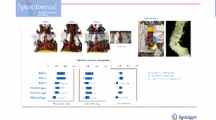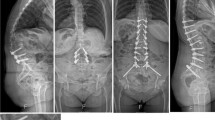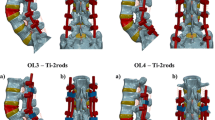Abstract
Purpose
To investigate the biomechanical effects of anterior column realignment (ACR) and pedicle subtraction osteotomy (PSO) on local lordosis correction, primary stability and rod strains.
Methods
Seven cadaveric spine segments (T12–S1) underwent ACR at L1–L2. A stand-alone hyperlordotic cage was initially tested and then supplemented with posterior bilateral fixation. The same specimens already underwent a PSO at L4 stabilized by two rods, a supplemental central rod (three rods) and accessory rods (four rods) with and without adjacent interbody cages (La Barbera in Eur Spine J 27(9):2357–2366, 2018). In vitro flexibility tests were performed under pure moments in flexion/extension (FE), lateral bending (LB) and axial rotation (AR) to determine the range of motion (RoM), while measuring the rod strains with strain gauge rosettes.
Results
Local lordosis correction with ACR (24.7° ± 3.7°) and PSO (25.1° ± 3.9°) was similar. Bilateral fixation significantly reduced the RoM (FE: 31%, LB: 2%, AR: 18%), providing a stability consistent with PSO constructs (p > 0.05); however, it demonstrates significantly higher rod strains compared to PSO constructs with lateral accessory rods and interbody cages in FE and AR (p < 0.05), while being comparable in FE or slightly higher in AR compared to PSO constructs with two and three rods.
Conclusion
Bilateral posterior fixation is highly recommended following ACR to provide adequate primary stability. However, primary rod strains in ACR were found comparable or higher than weak PSO construct associated with frequent rod failure; therefore, caution is recommended.
Graphic abstract
These slides can be retrieved under Electronic Supplementary Material.









Similar content being viewed by others
References
Lamartina C, Berjano P (2014) Classification of sagittal imbalance based on spinal alignment and compensatory mechanisms. Eur Spine J 23(6):1177–1189. https://doi.org/10.1007/s00586-014-3227-9
Berjano P, Bassani R, Casero G, Sinigaglia A, Cecchinato R, Lamartina C (2013) Failures and revisions in surgery for sagittal imbalance: analysis of factors influencing failure. Eur Spine J 22(Suppl 6):S853–S858. https://doi.org/10.1007/s00586-013-3024-x
Smith JS, Shaffrey CI, Glassman SD, Berven SH, Schwab FJ, Hamill CL, Horton WC, Ondra SL, Sansur CA, Bridwell KH, Spinal Deformity Study Group (2011) Risk-benefit assessment of surgery for adult scoliosis: an analysis based on patient age. Spine (Phila Pa 1976) 36(10):817–824. https://doi.org/10.1097/BRS.0b013e3181e21783
Dorward IG, Lenke LG (2010) Osteotomies in the posterior-only treatment of complex adult spinal deformity: a comparative review. Neurosurg Focus 28(3):E4. https://doi.org/10.3171/2009.12.FOCUS09259
La Barbera L, Brayda-Bruno M, Liebsch C, Villa T, Luca A, Galbusera F, Wilke HJ (2018) Biomechanical advantages of supplemental accessory and satellite rods with and without interbody cages implantation for the stabilization of pedicle subtraction osteotomy. Eur Spine J 27(9):2357–2366. https://doi.org/10.1007/s00586-018-5623-z
Smith JS, Shaffrey CI, Klineberg E et al (2017) Complication rates associated with 3-column osteotomy in 82 adult spinal deformity patients: retrospective review of a prospectively collected multicenter consecutive series with 2-year follow-up. J Neurosurg Spine 27(4):444–457. https://doi.org/10.3171/2016.10.SPINE16849
Bridwell KH, Lewis SJ, Lenke LG (2003) Pedicle subtraction osteotomy for the treatment of fixed sagittal imbalance. J Bone Jt Surg Am 85:454–463
Smith JS, Shaffrey CI, Ames CP, Demakakos J, Fu KMG, Keshavarzi S, Li CMY, Deviren V, Schwab FJ, Lafage V, Bess S (2012) Assessment of symptomatic rod fracture after posterior instrumented fusion for adult spinal deformity. Neurosurgery 71(4):862–867. https://doi.org/10.1227/NEU.0b013e3182672aab
Luca A, Lovi A, Galbusera F, Brayda-Bruno M (2014) Revision surgery after PSO failure with rod breakage: a comparison of different techniques. Eur Spine J 23(6):610–615. https://doi.org/10.1007/s00586-014-3555-9
Gupta S, Eksi MS, Ames CP, Deviren V, Durbin-Johnson B, Smith JS, Gupta MC (2017) A novel 4-rod technique offers potential to reduce rod breakage and pseudarthrosis in pedicle subtraction osteotomies for adult spinal deformity correction. Oper Neurosurg (Hagerstown). https://doi.org/10.1093/ons/opx151
Hyun SJ, Lenke LG, Kim YC, Koester L, Blanke KM (2014) Comparison of standard 2-rod constructs to multiple-rod constructs for fixation across 3-column spinal osteotomies. Spine 39(22):1899–1904. https://doi.org/10.1097/BRS.0000000000000556
Kim YJ, Bridwell KH, Lenke LG, Cheh G, Baldus C (2007) Results of lumbar pedicle subtraction osteotomies for fixed sagittal imbalance: a minimum 5-year follow-up study. Spine 32(20):2189–2197. https://doi.org/10.1097/BRS.0b013e31814b8371
Saigal R, Mundis GM Jr, Eastlack R, Uribe JS, Phillips FM, Akbarnia BA (2016) Anterior column realignment (ACR) in adult sagittal deformity correction: technique and review of the literature. Spine (Phila Pa 1976) 41(Suppl. 8):S66–S73. https://doi.org/10.1097/BRS.0000000000001483
Uribe JS, Schwab F, Mundis GM, Xu DS, Januszewski J, Kanter AS, Okonkwo DO, Hu SS, Vedat D, Eastlack R, Berjano P, Mummaneni PV (2019) The comprehensive anatomical spinal osteotomy and anterior column realignment classification. J Neurosurg Spine 29(5):565–575. https://doi.org/10.3171/2018.4.SPINE171206
Cheung ZB, Chen DH, White SJW, Kim JS, Cho SK (2019) Anterior column realignment in adult spinal deformity: a case report and review of the literature. World Neurosurg 123:e379–e386. https://doi.org/10.1016/j.wneu.2018.11.174
Deukmedjian AR, Dakwar E, Ahmadian A, Smith DA, Uribe JS (2012) Early outcomes of minimally invasive anterior longitudinal ligament release for correction of sagittal imbalance in patients with adult spinal deformity. Sci World J 2012:789698. https://doi.org/10.1100/2012/789698
Mundis GM Jr, Turner JD, Kabirian N, Pawelek J, Eastlack RK, Uribe J, Klineberg E, Bess S, Ames C, Deviren V, Nguyen S, Lafage V, Akbarnia BA, International Spine Study Group (2017) Anterior column realignment has similar results to pedicle subtraction osteotomy in treating adults with sagittal plane deformity. World Neurosurg 105:249–256. https://doi.org/10.1016/j.wneu.2017.05.122
Deukmedjian AR, Le TV, Baaj AA, Dakwar E, Smith DA, Uribe JS (2012) Anterior longitudinal ligament release using the minimally invasive lateral retroperitoneal transpsoas approach: a cadaveric feasibility study and report of 4 clinical cases. J Neurosurg Spine 17(6):530539. https://doi.org/10.3171/2012.8.SPINE12432
Hosseini P, Mundis GM Jr, Eastlack RK, Bagheri R, Vargas E, Tran S, Akbarnia BA (2017) Preliminary results of anterior lumbar interbody fusion, anterior column realignment for the treatment of sagittal malalignment. Neurosurg Focus 43(6):E6. https://doi.org/10.3171/2017.8.FOCUS17423
Berjano P, Cecchinato R, Sinigaglia A, Damilano M, Ismael MF, Martini C, Villafañe JH, Lamartina C (2015) Anterior column realignment from a lateral approach for the treatment of severe sagittal imbalance: a retrospective radiographic study. Eur Spine J 24(Suppl 3):433–438. https://doi.org/10.1007/s00586-015-3930-1
Akbarnia BA, Mundis GM Jr, Moazzaz P, Kabirian N, Bagheri R, Eastlack RK, Pawelek JB (2014) Anterior column realignment (ACR) for focal kyphotic spinal deformity using a lateral transpsoas approach and ALL release. J Spinal Disord Tech 27(1):29–39. https://doi.org/10.1097/BSD.0b013e318287bdc1
Le TV, Baaj AA, Dakwar E, Burkett CJ, Murray G, Smith DA, Uribe JS (2012) Subsidence of polyetheretherketone intervertebral cages in minimally invasive lateral retroperitoneal transpsoas lumbar interbody fusion. Spine (Phila Pa 1976) 37(14):1268–1273. https://doi.org/10.1097/BRS.0b013e3182458b2f
Luca A, Ottardi C, Sasso M, Prosdocimo L, La Barbera L, Brayda-Bruno M, Galbusera F, Villa T (2017) Instrumentation failure following pedicle subtraction osteotomy: the role of rod material, diameter, and multi-rod constructs. Eur Spine J 26(3):764–770. https://doi.org/10.1007/s00586-016-4859-8
Luca A, Ottardi C, Lovi A, Brayda-Bruno M, Villa T, Galbusera F (2017) Anterior support reduces the stresses on the posterior instrumentation after pedicle subtraction osteotomy: a finite-element study. Eur Spine J 26(Suppl 4):450–456. https://doi.org/10.1007/s00586-017-5084-9
Kim C, Harris JA, Muzumdar A, Khalil S, Sclafani JA, Raiszadeh K, Bucklen BS (2017) The effect of anterior longitudinal ligament resection on lordosis correction during minimally invasive lateral lumbar interbody fusion: biomechanical and radiographic feasibility of an integrated spacer/plate interbody reconstruction device. Clin Biomech (Bristol Avon) 43:102–108. https://doi.org/10.1016/j.clinbiomech.2017.02.006
Uribe JS, Smith DA, Dakwar E, Baaj AA, Mundis GM, Turner AW, Cornwall GB, Akbarnia BA (2012) Lordosis restoration after anterior longitudinal ligament release and placement of lateral hyperlordotic interbody cages during the minimally invasive lateral transpsoas approach: a radiographic study in cadavers. J Neurosurg Spine 17(5):476–485. https://doi.org/10.3171/2012.8.SPINE111121
Uribe JS, Harris JE, Beckman JM, Turner AW, Mundis GM, Akbarnia BA (2015) Finite element analysis of lordosis restoration with anterior longitudinal ligament release and lateral hyperlordotic cage placement. Eur Spine J 24(Suppl 3):420–426. https://doi.org/10.1007/s00586-015-3872-7
Kornblum MB, Turner AW, Cornwall GB, Zatushevsky MA, Phillips FM (2013) Biomechanical evaluation of stand-alone lumbar polyether-ether-ketone interbody cage with integrated screws. Spine J 13(1):77–84. https://doi.org/10.1016/j.spinee.2012.11.013
Laws CJ, Coughlin DG, Lotz JC, Serhan HA, Hu SS (2012) Direct lateral approach to lumbar fusion is a biomechanically equivalent alternative to the anterior approach: an in vitro study. Spine (Phila Pa 1976) 37(10):819–825. https://doi.org/10.1097/BRS.0b013e31823551aa
Cappuccino A, Cornwall GB, Turner AW, Fogel GR, Duong HT, Kim KD, Brodke DS (2010) Biomechanical analysis and review of lateral lumbar fusion constructs. Spine (Phila Pa 1976) 35(26 Suppl):S361–S367. https://doi.org/10.1097/BRS.0b013e318202308b
Ploumis A, Wu C, Fischer G, Mehbod AA, Wu W, Faundez A, Transfeldt EE (2008) Biomechanical comparison of anterior lumbar interbody fusion and transforaminal lumbar interbody fusion. J Spinal Disord Tech 21(2):120–125. https://doi.org/10.1097/BSD.0b013e318060092f
Januszewski J, Beckman JM, Harris JE, Turner AW, Yen CP (2017) Uribe JS (2017) Biomechanical study of rod stress after pedicle subtraction osteotomy versus anterior column reconstruction: a finite element study. Surg Neurol Int 8:207. https://doi.org/10.4103/sni.sni_44_17
Watanabe K, Lenke LG, Daubs MD, Kim YW, Kim YB, Watanabe K, Stobbs G (2008) A central hook-rod construct for osteotomy closure: a technical note. Spine (Phila Pa 1976) 33(10):1149–1155. https://doi.org/10.1097/BRS.0b013e31816f5f23
Wilke H-J, Claes L, Schmitt H, Wolf S (1994) A universal spine tester for in vitro experiments with muscle force simulation. Eur Spine J 3(2):91–97
La Barbera L, Villa T (2017) Toward the definition of a new worst-case paradigm for the preclinical evaluation of posterior spine stabilization devices. Proc Inst Mech Eng H 231(2):176–185. https://doi.org/10.1177/0954411916684365
La Barbera L, Villa T (2016) ISO 12189 standard for the preclinical evaluation of posterior spinal stabilization devices—I: assembly procedure and validation. Proc Inst Mech Eng H 230(2):122–133. https://doi.org/10.1177/0954411915621587
La Barbera L, Ottardi C, Villa T (2015) Comparative analysis of international standards for the fatigue testing of posterior spinal fixation systems: the importance of preload in ISO 12189. Spine J 15(10):2290–2296. https://doi.org/10.1016/j.spinee.2015.07.461
Lehman RA, Kang DG, Wagner SC, Paik H, Cardoso MJ, Bernstock JD, Dmitriev AE (2015) Biomechanical stability of transverse connectors in the setting of a thoracic pedicle subtraction osteotomy. Spine J 15:1629–1635. https://doi.org/10.1016/j.spinee.2015.03.010
Lafage V, Schwab F, Vira S, Hart R, Burton D, Smith JS, Boachie-Adjei O, Shelokov A, Hostin R, Shaffrey CI, Gupta M, Akbarnia BA, Bess S, Farcy JP (2011) Does vertebral level of pedicle subtraction osteotomy correlate with degree of spinopelvic parameter correction? J Neurosurg Spine 14(2):184–191. https://doi.org/10.3171/2010.9.SPINE10129
Berjano P, Aebi M (2015) Pedicle subtraction osteotomies (PSO) in the lumbar spine for sagittal deformities. Eur Spine J 24(Suppl 1):S49–57. https://doi.org/10.1007/s00586-014-3670-7
Berti F, La Barbera L, Piovesan A, Allegretti D, Ottardi C, Villa T, Pennati G (2018) Residual stresses in titanium spinal rods: effects of two contouring methods and material plastic properties. J Biomech Eng. https://doi.org/10.1115/1.4040451
Piovesan A, Berti F, Villa T, Pennati G, La Barbera L (2019) Computational and experimental fatigue analysis of contoured spinal rods. J Biomech Eng. https://doi.org/10.1115/1.4042767
Acknowledgements
The study was funded by the Scoliosis Research Society through a New Investigator Grant awarded to the first author. The implants and surgical tools for specimens’ preparation and instrumentation were provided by DePuy Synthes (Raynham, MA, USA), Medtronic Sofamor Danek (Minneapolis, MN, USA) and NuVasive (San Diego, CA, USA). The authors gratefully acknowledge Gloria Casaroli Ph.D., Maria Luisa Ruspi, Lisa Flachmüller and Theodor Di Pauli von Treuheim for their assistance during specimens’ preparation.
Author information
Authors and Affiliations
Corresponding author
Ethics declarations
Conflict of interest
The authors declare that they have no conflict of interest related to the content of the current study.
Additional information
Publisher's Note
Springer Nature remains neutral with regard to jurisdictional claims in published maps and institutional affiliations.
Electronic supplementary material
Below is the link to the electronic supplementary material.
Supplementary Material – Figure 1
Range of motion (RoM) and neutral zone (NZ) on the intact condition and following ACR with a standalone hyperlordotic ACR-Cage and with bilateral instrumentation with 2 rods (ACR-Cage+2) in flexion-extension (FE). Statistically significant differences compared to ACR-Cage condition are denoted with “a”. (TIFF 155 kb)
Supplementary Material – Figure 2
Range of motion (RoM) and neutral zone (NZ) on the intact condition and following ACR with a standalone hyperlordotic ACR-Cage and with bilateral instrumentation with 2 rods (ACR-Cage+2) in lateral bending (LB). Statistically significant differences compared to ACR-Cage condition are denoted with “a”. (TIFF 154 kb)
Supplementary Material – Figure 3
Range of motion (RoM) and neutral zone (NZ) on the intact condition and following ACR with a standalone hyperlordotic ACR-Cage and with bilateral instrumentation with 2 rods (ACR-Cage+2) in axial rotation (AR). Statistically significant differences compared to ACR-Cage condition are denoted with “a”. (TIFF 155 kb)
Rights and permissions
About this article
Cite this article
La Barbera, L., Wilke, HJ., Liebsch, C. et al. Biomechanical in vitro comparison between anterior column realignment and pedicle subtraction osteotomy for severe sagittal imbalance correction. Eur Spine J 29, 36–44 (2020). https://doi.org/10.1007/s00586-019-06087-x
Received:
Revised:
Accepted:
Published:
Issue Date:
DOI: https://doi.org/10.1007/s00586-019-06087-x




